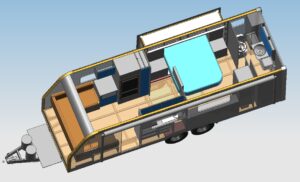Building a caravan or RV project can be compared to building a small house. It is not possible to learn the subject in a day but it is advisable to work through it step by step and do your due diligence:
- Do all your research first – to see what’s available
- Identify what you want – so many choices to make
- Create your design – of the complete product and each component
- Ensure everything is compliant and certified as required
- Cost the project – to ensure it’s within budget
- and finally build what you have designed.
Many DIY customers put their ideas together by doing some of the tasks below:
- Visit local or State Caravan & Camping Shows to get inspiration from the wide choice of products on the market – from caravans to individual appliances
- Drawing sketches of your DIY project specifying the shape and size of the ‘shell’ you are intending to build
- Developing a detailed floor-plan so you know you can get all the key items you require inside
- Engage an engineer to design the chassis and agree to certify the compliance of the build when it is completed
- Create a basic ‘Bill of Materials’ for the project – this lists all the main parts and components you intend to include so you can check it is in line with your cost budget. If you have not made a Bill of Materials before this document below is a good starting point – simply delete the items you don’t need and add what you do need.
- Consider where you will build the project, who will be involved and all the logistic challenges that it may create.
The design of the project is absolutely the key to a successful build. At DIY Caravans the customer is usually the designer and the builder – though he or she may use a drafter to create some drawings and definitely get some assistance with the building process.
Knowing what you will include and how it all goes together really needs to be decided before you start purchasing items since you may not be able to make changes later.
By using ‘made to order’ items like Cruisemaster suspension kits and Composite panel kits you really can specify the precise product you require for your build. This way it also goes together perfectly thereby enhancing its performance, creating an aesthetic look whilst raising the resale value and providing you and your family with a lot of fun and satisfaction. In our experience many DIY projects are built to a quality higher than many manufacturers.
Most DIY projects can usefully be divided into an number of Sections – each of which needs to be considered in terms of Design, choice of components and how it will physically be constructed and complement the other features. Typical sections include:
- Chassis
- Shell
- External Hardware
- Cabinetry
- Internal Hardware
- Appliances
- Sanitation
- Plumbing
- Electric – 240volt
- Electric – 12 volt
- Gas & Compliance
Each of these areas may require different suppliers and expertise to help you achieve all the benefits of your design. It is a good idea to consider your project in terms of the 11 categories above and make sure you haven’t forgotten anything. In due course we will go through these subjects in more detail.
The importance of weight.
As well as aiming to keep within your budget $$, it is equally important to assess what the project will weigh in Kgs.
Whether it is a motor-home or a trailer type project (eg Caravan, camper trailer) there will be a maximum weight allowed when it is completed. This will be the GVM in the case of a vehicle or the ATM in the case of a trailer and will be stamped on the Compliance Plate. Please click here for detailed definitions of the Mass terminology used.
As the designer/builder of a new product you will be able to select the weight rating you want. If you are refurbishing a current product you will need to use the weight rating it already has – unless you have it re-rated by a qualified engineer.
The key is you will need to estimate the weight (kgs) of all your components you intend to use so you can calculate the expected tare mass once finished and make sure you have sufficient payload (in kgs) to carry all the items you want to take with you.
Clearly every item or component you include in your build has a mass (in Kgs) and using ultra lightweight products can sometimes cost more.


